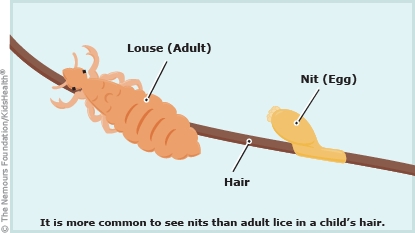Head Lice: How to Care for Your Child
Head lice are tiny wingless insects that live on the scalp and feed on small amounts of human blood. Adult lice are grayish-white or tan and about the size of sesame seeds. Lice eggs, called nits, attach to the hair shaft and may resemble dandruff, but are not easily removed. Head lice are not dangerous and don't spread disease. Having head lice is not a sign of uncleanliness or poor hygiene.
Head lice can be treated with a medicated shampoo or rinse you can buy in stores without a prescription. If the lice do not respond to these treatments, prescription medicine might be needed.


The two main ways to treat lice are by using medicine and removing by hand:
-
Use medicated shampoo or rinse as directed by your health care provider or follow the label's instructions.
-
Some treatments are only applied once. Others might need to be repeated 7–10 days later.
-
Some treatments are safe for kids as young as 2 months, but others are safe only for kids 2 years and older.
-
Sometimes lice can be resistant to some medicines, which means the treatment won't work. Check with your health care provider if you think the treatment isn't working (for example, if you see live lice that are still very active 12 hours after treatment). They might recommend a different treatment.
-
Some treatments need to be left in for only 10 minutes before rinsing out. Others might need to be left for 8–12 hours. Do not leave shampoo or rinse in longer than recommended.
-
Don't use conditioner or a shampoo/conditioner combination before using a medicated treatment.
-
Don't wash your child's hair for 1–2 days after using a medicated treatment.
-
Don't use a hair dryer, flat iron, or curling iron after treating your child for head lice.
-
You can use the "comb-out method" to remove lice and nits after treating with medicated shampoo or rinse. It is also an option for anyone who doesn't want to use a medicated shampoo or rinse, and for children 2 months old or younger who should not use medicated lice treatment.
-
Use a fine-toothed comb to comb through your child's wet hair one section at a time. You can put lots of conditioner in the wet hair before combing to make the hair more slippery and easier to comb through. After each comb-through, wipe the comb on a wet paper towel to inspect for lice or nits.
-
Do this every 2–3 days for 2–3 weeks after the last live louse was seen.
To prevent lice from coming back and spreading in the family:
-
Wash your child's recently worn clothing and bedding in hot water. Dry them on the hot cycle of the dryer for at least 20 minutes. Items that can't be washed, such as blankets or stuffed animals, can be dry cleaned or sealed in plastic bags for 2 weeks.
-
Vacuum all carpets and upholstery in your house or car. Do not use lice sprays or other insecticides.
-
Soak hair care items such as combs or barrettes in hot water (at least 130°F/54.4°C) for 10 minutes or throw them away.
-
Check everyone in your household for lice and treat family members, if necessary.

-
Your child still has lice 2 weeks after starting home treatment.
-
Your child's scalp is very red or swollen or has pus.
-
You feel swollen lymph nodes (glands) on the back or front of your child's neck.

What are the signs and symptoms of lice? Head lice often cause the scalp to be very itchy, especially behind the ears and at the back of the neck. The itch usually doesn't happen right away. Depending on how sensitive a child's skin is to the lice, it can sometimes take weeks for kids with lice to start scratching. There may also be small red bumps or sores. Your child might feel something moving in their hair.
How do lice spread? Lice spread through head-to-head contact. They can't fly or jump, but they have claws that let them crawl and cling to hair. Less commonly they can spread when people share bed linens, combs, brushes, and hats, but they usually cannot survive being off a human body for more than 48 hours. A person cannot get lice from pets.
Can my child go to school if they have lice? The American Academy of Pediatrics states that children should not miss any school because of lice. In most cases, a child who has lice should stay at school until the end of the day, go home and get treatment, and return to school the next day. While they are at school, kids should avoid head-to-head contact with other kids. It can help to put long hair up in a bun, braid, or ponytail.